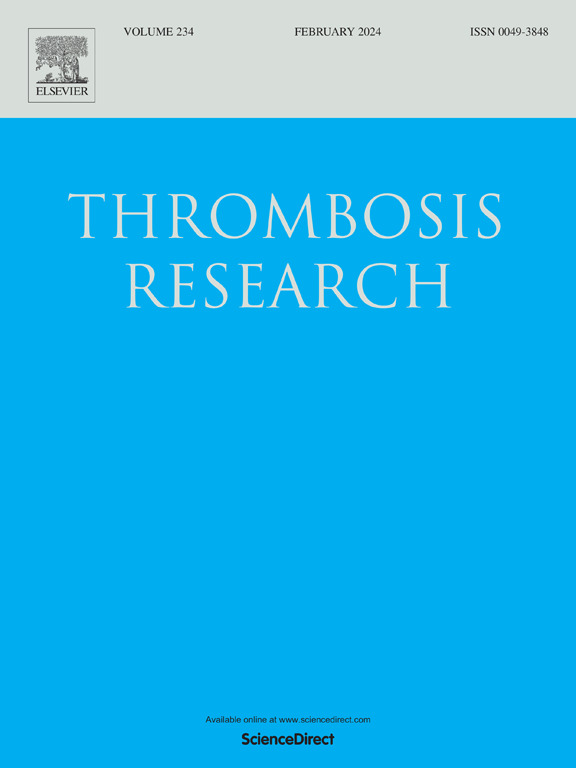Prescribing preferences for reduced-dose direct oral anticoagulation for extended-phase venous thromboembolism treatment
IF 3.7
3区 医学
Q1 HEMATOLOGY
引用次数: 0
Abstract
Background
Direct anticoagulants (DOACs), apixaban and rivaroxaban, are used for the treatment of venous thromboembolism (VTE) and have product labeling to dose-reduce for extended-phase secondary prevention of VTE. The objective of this study was to better understand prescribing patterns of DOACs among a broad cohort of clinicians.
Methods
In this secondary analysis of a survey deployed to two distinct populations of clinicians, thrombosis specialists and primary care physicians (PCPs), we used descriptive statistics, Fisher's exact test, and regression to explore relationships between respondent demographics and prescribing behaviors.
Results
Among 336 respondents, 12 % were pharmacists, 23 % were PCPs, and 65 % were specialists. Most (59 %) practiced in an academic setting, and 18 % practiced outside of North America. When considering provider type, 88 % of pharmacists, 78 % of specialists, and 61 % of PCPs indicated that they dose-reduce DOACs for extended-phase therapy for the secondary prevention of VTE (p-value = 0.002). PCPs were most likely to engage in temporary dose-escalation (p-value < 0.001) when presented with various scenarios of increased risk. Providers who prescribed DOACs in >250 patients were also more likely to dose-reduce (aOR 2.41, 1.24–4.82 95 % CI, p-value = 0.01). Pharmacists overwhelmingly preferred prescribing apixaban, while PCPs and specialists were more balanced between prescribing apixaban and rivaroxaban (p-value < 0.001).
Conclusion
Most clinicians elect to dose-reduce DOACs during the extended phase of anticoagulation. Provider type and number of patients correlated with prescribing practices. These findings identify opportunities to advance clinician education surrounding dose-reduction when clinically indicated.
延长期静脉血栓栓塞治疗中减少剂量直接口服抗凝的处方偏好
背景:直接抗凝剂(doac),阿哌沙班和利伐沙班,用于治疗静脉血栓栓塞(VTE),并有产品标签,以减少剂量延长期二级预防VTE。本研究的目的是为了更好地了解DOACs的处方模式在一个广泛的临床队列。方法对两种不同人群的临床医生、血栓专家和初级保健医生(pcp)进行了调查分析,我们使用描述性统计、Fisher精确检验和回归来探讨受访者人口统计学与处方行为之间的关系。结果336名受访医师中,药师占12%,pcp占23%,专科占65%。大多数(59%)在学术环境中练习,18%在北美以外的地方练习。当考虑提供者类型时,88%的药剂师、78%的专科医生和61%的pcp表示,他们会减少doac的剂量,用于静脉血栓栓塞二级预防的延长期治疗(p值= 0.002)。pcp最有可能出现暂时剂量递增(p值<;0.001),当出现各种风险增加的情景时。在250名患者中使用doac的提供者也更有可能减少剂量(aOR 2.41, 1.24-4.82 95% CI, p值= 0.01)。绝大多数药剂师倾向于开阿哌沙班,而pcp和专科医生在开阿哌沙班和利伐沙班之间更为平衡(p值<;0.001)。结论大多数临床医生在抗凝延长期选择降低doac的剂量。提供者类型和患者数量与处方实践相关。这些发现确定了在临床指征时围绕减少剂量推进临床医生教育的机会。
本文章由计算机程序翻译,如有差异,请以英文原文为准。
求助全文
约1分钟内获得全文
求助全文
来源期刊

Thrombosis research
医学-外周血管病
CiteScore
14.60
自引率
4.00%
发文量
364
审稿时长
31 days
期刊介绍:
Thrombosis Research is an international journal dedicated to the swift dissemination of new information on thrombosis, hemostasis, and vascular biology, aimed at advancing both science and clinical care. The journal publishes peer-reviewed original research, reviews, editorials, opinions, and critiques, covering both basic and clinical studies. Priority is given to research that promises novel approaches in the diagnosis, therapy, prognosis, and prevention of thrombotic and hemorrhagic diseases.
 求助内容:
求助内容: 应助结果提醒方式:
应助结果提醒方式:


